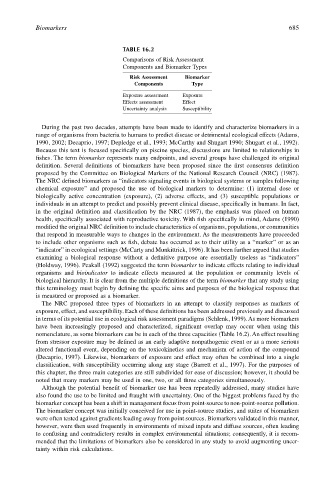Page 705 - The Toxicology of Fishes
P. 705
Biomarkers 685
TABLE 16.2
Comparisons of Risk Assessment
Components and Biomarker Types
Risk Assessment Biomarker
Components Type
Exposure assessment Exposure
Effects assessment Effect
Uncertainty analysis Susceptibility
During the past two decades, attempts have been made to identify and characterize biomarkers in a
range of organisms from bacteria to humans to predict disease or detrimental ecological effects (Adams,
1990, 2002; Decaprio, 1997; Depledge et al., 1993; McCarthy and Shugart 1990; Shugart et al., 1992).
Because this text is focused specifically on piscine species, discussions are limited to relationships in
fishes. The term biomarker represents many endpoints, and several groups have challenged its original
definition. Several definitions of biomarkers have been proposed since the first consensus definition
proposed by the Committee on Biological Markers of the National Research Council (NRC) (1987).
The NRC defined biomarkers as “indicators signaling events in biological systems or samples following
chemical exposure” and proposed the use of biological markers to determine: (1) internal dose or
biologically active concentration (exposure), (2) adverse effects, and (3) susceptible populations or
individuals in an attempt to predict and possibly prevent clinical disease, specifically in humans. In fact,
in the original definition and classification by the NRC (1987), the emphasis was placed on human
health, specifically associated with reproductive toxicity. With fish specifically in mind, Adams (1990)
modified the original NRC definition to include characteristics of organisms, populations, or communities
that respond in measurable ways to changes in the environment. As the measurements have proceeded
to include other organisms such as fish, debate has occurred as to their utility as a “marker” or as an
“indicator” in ecological settings (McCarty and Munkittrick, 1996). It has been further argued that studies
examining a biological response without a definitive purpose are essentially useless as “indicators”
(Holdway, 1996). Peakall (1992) suggested the term biomarker to indicate effects relating to individual
organisms and bioindicator to indicate effects measured at the population or community levels of
biological hierarchy. It is clear from the multiple definitions of the term biomarker that any study using
this terminology must begin by defining the specific aims and purposes of the biological response that
is measured or proposed as a biomarker.
The NRC proposed three types of biomarkers in an attempt to classify responses as markers of
exposure, effect, and susceptibility. Each of these definitions has been addressed previously and discussed
in terms of its potential use in ecological risk assessment paradigms (Schlenk, 1999). As more biomarkers
have been increasingly proposed and characterized, significant overlap may occur when using this
nomenclature, as some biomarkers can be in each of the three capacities (Table 16.2). An effect resulting
from stressor exposure may be defined as an early adaptive nonpathogenic event or as a more serious
altered functional event, depending on the toxicokinetics and mechanism of action of the compound
(Decaprio, 1997). Likewise, biomarkers of exposure and effect may often be combined into a single
classification, with susceptibility occurring along any stage (Barrett et al., 1997). For the purposes of
this chapter, the three main categories are still subdivided for ease of discussion; however, it should be
noted that many markers may be used in one, two, or all three categories simultaneously.
Although the potential benefit of biomarker use has been repeatedly addressed, many studies have
also found the use to be limited and fraught with uncertainty. One of the biggest problems faced by the
biomarker concept has been a shift in management focus from point-source to non-point-source pollution.
The biomarker concept was initially conceived for use in point-source studies, and suites of biomarkers
were often tested against gradients leading away from point sources. Biomarkers validated in this manner,
however, were then used frequently in environments of mixed inputs and diffuse sources, often leading
to confusing and contradictory results in complex environmental situations; consequently, it is recom-
mended that the limitations of biomarkers also be considered in any study to avoid augmenting uncer-
tainty within risk calculations.

